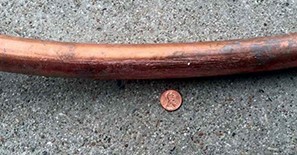Contact Us:
- (847) 356-6100
- M - F 8:30am - 4:30pm
- Staff Directory
- Get Directions
Lead Service Line Information
Lead Service Line Information
The Village of Lake Villa understands the importance of clean and safe water for you and your family. This page is designed to provide you with easy-to-understand information about lead in water service lines, why it matters, and what you can do to keep your water safe.
A water service line connects the water main (usually under the street) to your home or business. Service line ownership is shared between the Village and property owners. The Village owns the portion from the water main to the Buffalo Box (the round metal box located in the parkway) or exterior water meter, and the property owner owns the portion from the B-Box or exterior water meter into the house.
Water Service Line Diagram

Recently, the Federal Government mandated that municipalities must find out where lead services are located throughout the community to begin the process of eliminating them. Lead, unlike other drinking water contaminants, is usually not present in the drinking water source or water main. It results from the service line or on-site plumbing itself. Lead gets into water at the tap when water corrodes lead in pipes, fixtures, and solder. The most impactful way to reduce the risk of exposure to lead in drinking water is to remove the lead service line that brings water to your home from the water main in the street.
What Is a Water Service Line and Who Owns It?
A water service line is the pipe that runs from the water main to a home or building’s internal plumbing. They are the pipes that carry water from the Village’s water main in the street into homes and other buildings. In Lake Villa, the water service lines are owned by the individual property owners, from the curb stop or b-box valve typically near the property line, to the water meter in the home.
Lead Service Lines
Lake Villa’s water mains are lead-free. However, some homes may have a service line that is made of lead or lead components. One of the primary sources for lead in drinking water in our homes is lead service lines (LSLs). LSLs transport treated public water into our homes and may leach lead from pipes into your drinking water. Older homes, especially those built before 1986, are more likely to have lead service lines, fixtures, and solder. However, even newer “lead-free” fixtures could contain lead.
Take Our Survey
We are surveying all homes built to identify existing lead service lines. Please complete this brief Water Service Line Material Survey to determine the material composition of your water lines. The information provided will also assist with updating our water meter inventory.
How Do I Check My Service Line’s Material?
To find out if you have a copper, lead, or galvanized steel service on your property, you (or your landlord) can perform a test on the water service line where it connects to the water meter to determine the material of the water service line on your property.
Steps to Check Your Service Line
The Village of Lake Villa performs regular testing for lead throughout the distribution system, as required by the Illinois Environmental Protection Agency (IEPA).
Lake Villa Water Service Line Material Inventory (arcgis.com)
Materials Needed: Key or coin, strong magnet
- Find the water meter on your property. This can be in a basement, crawl space or other exterior wall.
- Look for the pipe that comes through the wall of your home and connects to the meter.
- Use a key or coin to gently scratch the pipe like you would scratch a lottery ticket. If the pipe is painted, use sandpaper to expose the metal first.
- Place the magnet on the pipe to see if it sticks to the pipe.
- Determine your pipe material and fill out the Water Service Line Material Survey.
IF YOUR PIPE IS COPPER:
The pipe may appear dull brown on the outside but will be the color of a bright penny if gently scratched. The magnet won't stick.

IF YOUR PIPE IS LEAD:
The pipe will appear dull and soft but will turn a shiny silver color when scratched. The magnet won't stick.

IF YOUR PIPE IS GALVANIZED STEEL:
The scratched area will remain a dull gray. If you have a galvanized steel pipe, you may still have a lead gooseneck on your service line. The magnet will stick.

Questions?
If you have questions or need assistance, please contact the Village Hall at 847-356-6100. A staff member can help walk you through the steps or schedule an appointment for the Water & Sewer department to come out and verify the service line material.
Additional Resources
 Site Design and Content Management
Site Design and Content Management